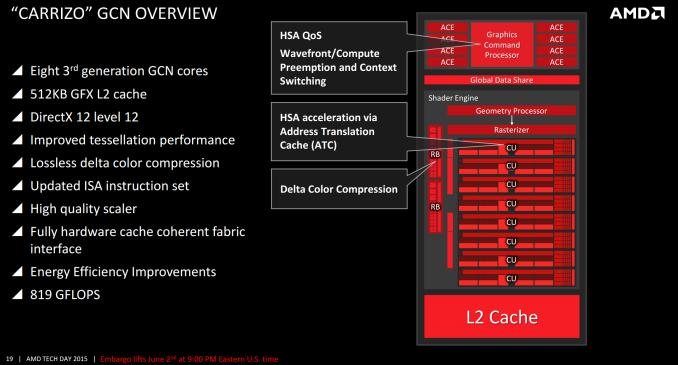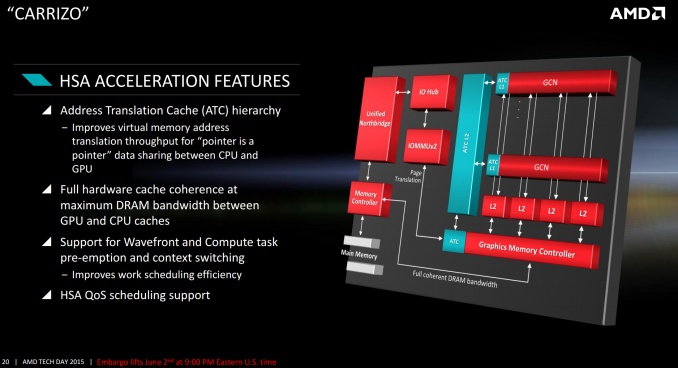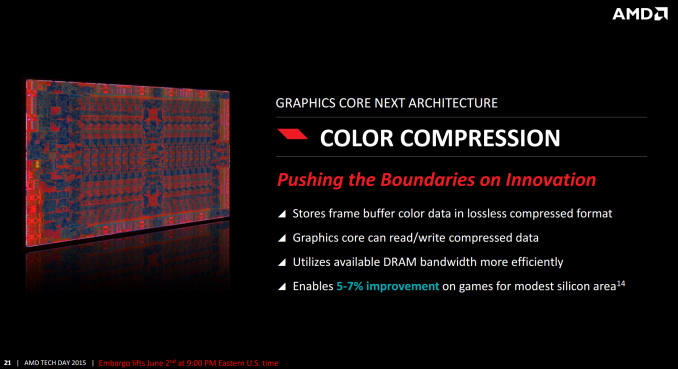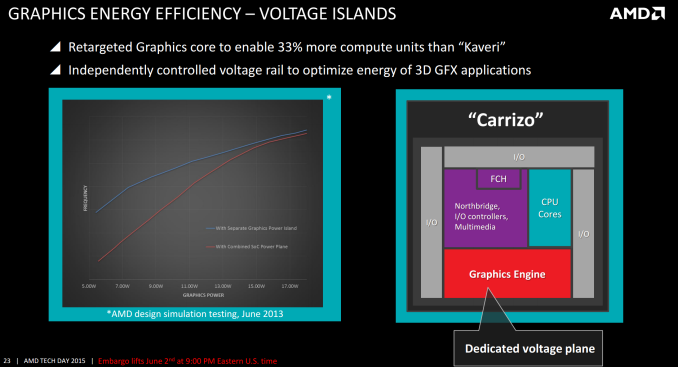AMD Launches Carrizo: The Laptop Leap of Efficiency and Architecture Updates
by Ian Cutress on June 2, 2015 9:00 PM ESTGraphics
The big upgrade in graphics for Carrizo is that the maximum number of compute units for a 15W mobile APU moves up from six (384 SPs) to eight (512 SPs), affording a 33% potential improvement. This means that the high end A10 Carrizo mobile APUs will align with the A10 Kaveri desktop APUs, although the desktop APUs will use 6x the power. Carrizo also moves to AMD’s third generation of Graphics Core Next, meaning GCN 1.2 and similar to Tonga based retail graphics cards (the R9 285).
This gives DirectX 12 support, but one of AMD’s aims with Carrizo is full HSA 1.0 support. Earlier this year when AMD first released proper Carrizo details, we were told that Carrizo will support the full HSA 1.0 draft as it currently stands as it has not been ratified, and they will not push back the launch of Carrizo until that happens. So there is a chance that Carrizo will not be certified has a fully HSA 1.0 compliant APU, but very few people are predicting major changes to the specification at this point before ratification that requires hardware adjustments.
The difference between Kaveri’s ‘HSA Ready’ and Carrizo’s ‘HSA Final’ nomenclature comes down to one main feature – context switching. Kaveri can do everything Carrizo can do, apart from this. Context switching allows the HSA device to switch between work asynchronously while it waits on the other part that needs to finish. I would imagine that if Kaveri came across work that required this, it would sit there idle waiting for work to finish before continuing, which means that Carrizo would be faster in this regard.
One of the key parts of HSA is pointer translation, allowing both the CPU and GPU to access the same memory despite their different interpretations of how the memory in the system is configured. One of the features on Carrizo will be the use of address translation caches inside the GPU, essentially keeping a record of which address points to which data and when an address is in a lower cache, that data can be accessed quicker. These ATC L1/L2 caches will be inside the compute units themselves as well as the GPU memory controller and an overriding ATC L2 beyond the regular L2 per compute unit.
Use of GCN 1.2 means that AMD can use their latest color compression algorithms with little effort – it takes a little more die area to implement (of which Excavator has more to play with than Kaveri), but affords performance improvements particularly in gaming. The texture data is stored losslessly to maintain visual fidelity, and move between graphics cores in this compressed state.
In yet more effort to suction power out of the system, the GPU will have its own dedicated voltage plane as part of the system, rather than a separate voltage island requiring its own power delivery mechanism as before. AMD’s latest numbers on the improvements here only date back to June 2013 via internal simulations, rather than an actual direct comparison.
All the performance metrics rolled in, and AMD is quoting a 65% performance improvement at 15W compared to Kaveri. The adjustment in design is allowing higher frequency for the same power, combined with the additional compute units and other enhancements for the overall score. At 35W the gain is less pronounced, but more akin to regular generational improvements anyway. What we see at 35W is what we would normally expect, and it pales in comparison to the 15W numbers.















137 Comments
View All Comments
VeixES - Wednesday, June 3, 2015 - link
Some OEM needs to pick this up fast.Carrizo based "NUC" device with HDMI2.0 output with more barebones approach than intel to reduce the cost of entry.
gostan - Wednesday, June 3, 2015 - link
Anandtech - AMD's marketing arm.bloodypulp - Wednesday, June 3, 2015 - link
Dumbest thing I've heard yet today.jabber - Thursday, June 4, 2015 - link
Everyone knows AMD has never had a marketing arm. That's why no one buys em.Seriously, the OEMs have moved on. Why bother with AMD when Intel sells because the average consumer has heard of Intel? Price doesn't come into it.
watzupken - Thursday, June 11, 2015 - link
To gostan, I find your comment above baseless and unconstructive to be honest. One article on AMD means AMD marketing arm. So what does that make you then?l_d_allan - Wednesday, June 3, 2015 - link
My impression is that it will be difficult (almost impossible?) for AMD to compete with a 28nm part against Intel's 14nm parts.And I think the next "tick tock" from Intel will be 10nm. Or not?
Novacius - Wednesday, June 3, 2015 - link
It'll be a tick, codenamed Cannonlake. But i don't expect it before the end of 2016/beginning of 2017.The_Assimilator - Wednesday, June 3, 2015 - link
Which will still be before AMD gets to 14nm.cjs150 - Wednesday, June 3, 2015 - link
Finally AMD release a reasonably power efficient chip.At 15W this is perfect for a passively cooled HTPC with 4k capability built in. I appreciate the HTPC market is small, but AMD have something that potentially (will reserve judgment until it is out and tested) beats everything Intel have comprehensively.
The problem for AMD will be that people like me already have a HTPC (in my case using i7-3770T which is overkill) and until the world moves to 4K there is no need to upgrade but if they produced something the size of Intel NUC but passively cooled I would be very tempted
watzupken - Wednesday, June 3, 2015 - link
I think this makes a very interesting APU. In fact, the most interesting APU from AMD to date. Unfortunately, it may not reach the shores from where I come from. It is either limited availability or the distros are not interested to carry in due to them expecting a low demand.